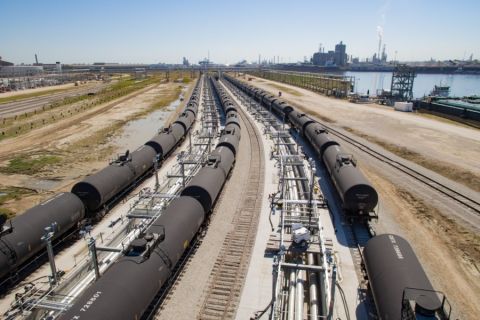
At the World Petroleum Congress, Exxon Mobil CEO Darren Woods (right), Hou Qijun, director and president of China National Petroleum Corp., and Amin Nasser, president and CEO of Aramco (left) discuss E&Ps' role in the energy transition with a moderator (far left). (Source: Hart Energy)
CALGARY, Alberta – The heads of three of the world’s largest oil and gas companies found common ground on the energy transition at the World Petroleum Congress on Sept. 18. Their unified message: don’t tear down the existing energy system before building the new.
Darren Woods, chairman and CEO of Exxon Mobil, said the sheer size and scale of today’s energy system is difficult to replace because of its utility: oil and gas is widely available, easily transportable and “energy dense.”
“There seems to be, I think, somewhat … wishful thinking that we're going to flip a switch and we'll go from where we're at today to where we'll be tomorrow,” Woods said during a Sept. 18 panel. “The reality is we've got to transition from where we're at today to where we go to.”
Amin Nasser, president and CEO of Aramco, said that oil and gas demand is growing, not declining. While alternative energy sources such as solar and wind helped to offset demand, the energy source a particular country uses depends on its economic maturity. Investment is needed for oil and gas in the interim or the world will continue to go backward as it uses more coal and all the efforts toward decarbonization “will go down the drain.”
“We need to continue investing in conventional energy while decarbonizing at the same time and build[ing] renewables at the speed we can,” Nasser said.
He said solutions need to take into consideration the affordability and security of energy supplies. “Otherwise, every country has a different priority and based on their economic maturity, their priority differs,” he said.
The solution needs to be truly global, because “there’s no barrier when it comes to emissions.”
Otherwise, the result will be more of the same, with one side building more “renewable plants and on the other side somebody is building more coal plants or biomass.”
“The world is not getting better,” Nasser said. “We will have more emissions.”
A moderating adjustment to the energy mix going forward would utilize more alternative forms of energy but, he said, that new energy needs to be in place before “discarding the old.”
Hou Qijun, director and president of China National Petroleum Corp., his words translated by an interpreter, had nearly the same response. While the energy transition needs to speed up, building a new energy system means maintaining a stable and secure supply of hydrocarbons. To do otherwise would be to put at risk the socioeconomic development of “the households of millions of people. Without the stable and secure supply of current energy, their lives will be significantly impacted.”
Woods said people may not fully appreciate the size of the global energy system and the challenge of moving “from what we have today, where incentives exist, to a new system where there is no incentive to pay the cost of that transition.”
Policies worldwide have tended to focus on an ‘either/or’ approach to fossil fuels rather than one that acknowledges both will be needed.
“In the short term, we need policy, all around the world, that focuses on the key objective of emissions reduction versus what we've seen developed in a lot of places around the world, which are policies that focus on eliminating today's available energy system, more specifically oil and gas,” Woods said.
A time will come when fossil fuels begin to transition, but the real challenge is to reduce emissions associated with the combustion of oil and gas, the Exxon CEO said.
“So we need clear consistent policy that focuses on that objective statement versus one that looks to eliminate what today is an incredibly important source of energy,” he said.
Woods also noted that some of the technology needed to reduce emissions in an affordable way still needs to be developed.
“The world today with the existing technology set cannot afford to solve this problem,” he said. “So we need significant advancements in technologies and breakthroughs and we need more funding and breakthrough technology so that we can lower the cost of addressing emissions.”
At some point, a market for carbon reduction must be developed that does not rely on government, he said.
“Governments cannot afford to subsidize reduced emissions in perpetuity,” Woods said. “If you look at what's happening today, particularly in the U.S. and the IRA [Inflation Reduction Act], it's a policy … being used to catalyze investment and to start to work to grow these new value chains in carbon reduction. But ultimately, market forces would have to come into play.”
Woods acknowledged that some critics have expressed skepticism regarding carbon capture and storage (CCS), although Exxon has “been doing that for decades as a company.”
The challenge with CCS is affordability, Woods said.
“You need high concentration CO2 streams to make it affordable, even with the subsidies,” he said.
Woods said that even with the current IRA incentives, capturing less concentrated CO2 streams is not economic.
“Our view was we get started with the high-concentration streams, get some big projects moving, see if we can get down the cost curve,” he said. “And then with time, either through lower cost technology or … higher incentives, we'll find a way to get to the rest of the CO2 streams,” he said.
The industry is clearly early in the learning curve, he said. And improving technology to lower CCS costs is where concerns or skepticism come into play.
“But frankly, the industry and society as a whole hasn't tried to develop that technology for this application,” he said. “I'm convinced that industry as a whole will make progress in that space,” he said.
Recommended Reading
Canadian Railway Companies Brace for Strike
2024-04-25 - A service disruption caused by a strike in May could delay freight deliveries of petrochemicals.
Enterprise’s SPOT Deepwater Port Struggles for Customers
2024-04-25 - Years of regulatory delays, a loss of commercial backers and slowing U.S. shale production has Enterprise Products Partners’ Sea Port Oil Terminal and rival projects without secured customers, energy industry executives say.
Report: Crescent Midstream Exploring $1.3B Sale
2024-04-23 - Sources say another company is considering $1.3B acquisition for Crescent Midstream’s facilities and pipelines focused on Louisiana and the Gulf of Mexico.
For Sale? Trans Mountain Pipeline Tentatively on the Market
2024-04-22 - Politics and tariffs may delay ownership transfer of the Trans Mountain Pipeline, which the Canadian government spent CA$34 billion to build.
Energy Transfer Announces Cash Distribution on Series I Units
2024-04-22 - Energy Transfer’s distribution will be payable May 15 to Series I unitholders of record by May 1.





